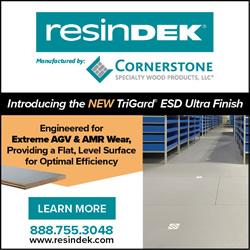Aside from robotics, computer vision still has a lot to offer manufacturing. The first things that come to mind are process control and quality control. For example, a CV system can be put to work on a production line for defect monitoring.
The Impact of Computer Vision on the Manufacturing Floor
Q&A with Brad Sliz, Director of Machine Learning | TackleAI
What impact has computer vision had on the manufacturing industry and the manufacturing floor?
It’s easy to forget that computer vision (CV), though a hot buzz-word today, has been a player in the manufacturing world for a long time. A lot of what computer vision offers can be described by its old moniker, machine vision, which has been a part of the industry for decades. Core to the machine vision discipline are a suite of CV algorithms that, when tuned to your environment, can perform really elegant visual perception / detection tasks. But modern computer vision is more than that. In fact, it's a game changer for manufacturing.
Traditional MV systems can be incredibly accurate; however, since these algorithms rely on parameters tuned by humans, they can also be brittle to small environmental changes (lighting, distance, etc.). Often, a machine vision system is the limiting factor in designing a process / system for a manufacturing task. In modern computer vision, all that has changed. With the latest advances in machine learning, high quality cameras, and computing, what used to be impossible is now possible.
Aside from robotics, how can computer vision technology be applied in manufacturing?
Aside from robotics, computer vision still has a lot to offer manufacturing. The first things that come to mind are process control and quality control. For example, a CV system can be put to work on a production line for defect monitoring, or to aid in tracking root-cause of system issues. Since modern cameras can detect light outside of the visible spectrum -being able to see ultraviolet and infrared light lets CV systems leverage new techniques for quality/defect tracking.
Applications of CV don’t have to stop at the plant floor, either. Even onboarding of new hires in manufacturing can be improved with automated document processing. The possibilities of CV in manufacturing are abound.
Is there a big barrier to entry to begin using CV-powered platforms?
Yes, modern CV has a big barrier-to-entry. Without much background in CV, it can be hard to know where to start. The first question is usually: build or buy? In the manufacturing industry, there aren’t many well established catered solutions that utilize modern CV, so for anything beyond the simplest use-cases, buying is difficult. That said, modern CV is different from traditional MV, and requires a vastly different skill set, even educational background (machine learning, software development, computer science), to build your own solutions. Further, the manufacturing industry is still dominated by the old hat, and new-age CV first talent is hard to come by, making the build option also difficult to pull off.
Can CV be used by plant floor workers on a day-to-day basis?
The best use-case for plant floor workers to use CV is in vision assisted decision making. Consider a quality-control / inspection process where a vision system proposes objects a worker should inspect closer. This is a way CV can make line-workers better at their jobs.
Another example of CV in manufacturing is as an assistive system for plant floor workers in the form of an integration with a step-by-step manual. In such a setup, a CV system can monitor human assemblers putting components together. This lets the CV system provide the next step, and also catch any missteps the assembler makes, thereby reducing assembly time, and improving quality.
How can computer vision improve safety on the manufacturing floor?
There’s a role for CV to play in manufacturing safety, but it likely won’t disrupt the status quo anytime soon. Area sensors, light curtains, and other traditional safety components should still be at the core of a well-designed safety system, but CV can add more around the edges. For example, it can be deployed in a complimentary role, performing anomaly detection, and assisting with root-cause analysis of safety breaches and system malfunctions. This may only scratch the surface of what CV can offer the safety space, but don’t expect it to replace an already robust platform.
What’s the role of computer vision in manufacturing compliance?
To help with manufacturing compliance, CV can be used to apply health and safety protocols. CV systems can be used to alert supervisors of unsafe work conditions. For example, privacy-preserving algorithms can monitor shop floors for proper PPE use and create alerts when they detect out-of-spec PPE. CV can also be used as a redundant safety measure for controlling and flagging entry to high-risk areas, and monitoring for safe use of heavy machinery.
.jpeg)
About Bradley Sliz
Bradley Sliz is the Director of Machine Learning and Computer Vision with over 10 years of experience in data science. Bradley specializes in building and deploying custom, scalable, computer vision and deep learning applications in the cloud and on the edge.
The content & opinions in this article are the author’s and do not necessarily represent the views of ManufacturingTomorrow
Comments (0)
This post does not have any comments. Be the first to leave a comment below.
Featured Product

